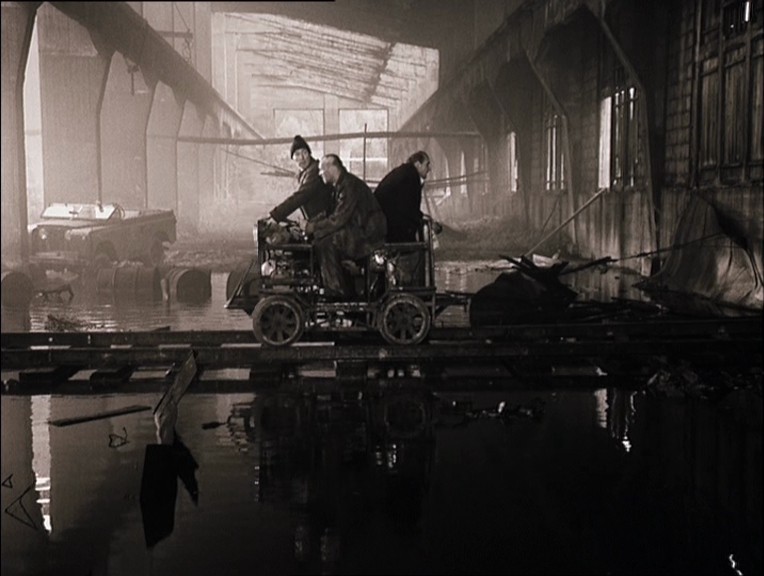A discussion on Tarkovsky’s Stalker - and the possible meaning of its story.
Tarkovsky’s masterpiece Stalker recently screened at a theater in Los Angeles and I was able to stay awake for it’s entirety.
My first attempted to watch Stalker was on my bed with a laptop, and about half an hour in… I woke up for the credits.
Before you go judging me, watch it and tell me if you don’t yawn a couple of times over the fifteen minute shot when the leads drowsily take naps.
Maybe it was the 64 ounce caffeinated beverage I was sipping, or the socially awkward silences and creaking seats that kept 600 of us holding our breaths so as not to ruin the mood - but the tension was real, and I was riveted to the screen this time, and learned a cuss-load about awesome filmmaking.
I’ve read a bit of Tarkovsky’s stuff in the past and here is a quote of his:
“I don’t do symbolism, I do story.”
He never said that exactly - but he meant it, and oh man can he pull it off.
So first go watch the movie Stalker… then ask yourself, “What did I just see?”
And don’t fall into the trap of symbolism… Tarkovsky hates direct parallels with anything… he calls it shallow preaching, bad filmmaking and detests it in his or other’s films.
So if the crippled daughter, the wandering dog, the reoccurring images of syringes don’t directly mean something… then what was their point? Why are they there? Again, what was the point of what we just saw?
While all of those objects matter and are intentionally put there by Tarkovsky —the direct A equals B symbolism is never as impactful as the subtle emotional story that he weaves. To him symbolism is a shallow attempt at good art.
So to answer “What was Stalker about?” I pose the following list of questions.
I beg you to answer them yourself. My answers will follow.
Depending on your starting point, your world view, or your belief systems there is a chance our answers will be the same, and a good chance they will differ and both could simultaneously be correct interpretations, another sign of masterful art; it touches you where you are at.
But don’t be fooled by your answers, he was trying to say something. The master artist always is attempting to express him or herself.
In this case things are so intentional, so perfect you’d be a fool to say Tarkovsky isn’t trying to “equip your soul for good” - another poorly paraphrased saying of his by me.
(See Questions Below)
QUESTIONS to ASK YOURSELF following a viewing of TARKOVSKY’S STALKER.
1. What is the purpose of the journey our three adventurers go on?
2. What does the Room supposedly give you?
3. Who goes into the Room during the film?
4. Why don’t the heroes go into the Room?
5. How does the movie start?
6. Again (think hard), does anyone go into the Room?
Next there are two speeches at the climax of the movie that must be discussed.
7. The Stalker’s speech. Point of discussion: Why did the Professor and the Writer lack faith?
8. The Wife of the Stalker’s speech. Point of discussion: What did happiness through sorrow mean to the wife? and was marrying the Stalker the right thing to do?
And some final questions (you’re doing great):
9. What is this movie about in one word?
10. What are we given (shown) at the very end?
11. Was your desire fulfilled from going into the Room?
12. Does this depend on your heart? (If this last question is confusing read on.)
(My Answers follow)
My ANSWERS:
(Again please watch and answer the above questions before reading below.)
1. What is the purpose of the journey our three adventurers go on?
To find the Room.
2. What does the Room supposedly give you?
Your heart’s true desire.
3. Who goes into the Room during the film?
Your initial answer might be no-one… but wait!
4. Why don’t the heroes go into the Room?
The Writer doesn’t want to see what his heart’s true desire actually is, he would rather sit in his nice house complaining than to actually look into his soul. Remember the warning about the old Stalker who went into the Room to heal his brother but came out rich instead, and then committed suicide when he realized that he wasn’t as noble as he thought.
The Professor was actually there to destroy the room, going into something far beyond what he could explain is something he never wanted.
The Stalker doesn’t go in because a ‘stalker’ isn’t supposed to go in. This is the unspoken law of those who can lead others to the room. Ie. The example given above about the stalker that did go in… it ruined him.
5. How does the movie start?
Funny question you might say… but very important to see whose perspective the movie belongs too… It’s us - the viewer. We walk slowly into a room through those beautiful antique doors to see the sleeping family.
6. Now to ask again does anyone go into the Room? (Hint: the Room fulfills one’s true desires.)
We do. Remember the shot looking back on the three travelers, worn out, the Professor throwing pieces of the bomb? We are in the Room as the audience looking back at them — and the Room will give you your heart’s true desire. Were you granted yours? A trick of the artist here is that the proof of the Room, the faith in it’s reality, is always at question. The heart of most viewers while on the journey to the Room actually want to know if there is a power, a magic. Should we believe it, or is it a sham. We therefore ask the same questions the characters ask throughout.
Next there are two speeches at the climax of the movie that must be discussed.
7. The Stalker’s speech. Point of discussion: Why did the Professor and the Writer lack faith?
They lacked faith because they have become so numb to the world, numb to taking risks, numb to living; so that their muscles of faith have atrophied to the point of non-existence. This is the point of the Stalker’s worn out frustrated speech -- that brings the Wife to speak - to us (the audience). She speaks directly to us!
8. The Wife of the Stalker’s speech. Point of discussion: What did happiness through sorrow mean to the wife? and was marrying the Stalker the right thing to do?
First off, why is she speaking to us? Because we are the ones on the journey! Suddenly what she says to us becomes key to hear what the master Tarkovsky is longing to share with us in his parable.
Happiness through sorrow is the point. Marrying the man with faith, joining together with faith doesn’t make the journey perfect but it makes it worth it.
And finally:
9. What is this movie about in one word?
I would argue faith. Not an abstract faith, but for purposes of the story -- faith in the Room (that it is a true judge of the heart, with the power to grant wishes).
10. What are we given (shown) at the very end?
The Cripple daughter moves items through telekinesis. A power beyond. Magic. A Miracle.
11. Was your desire fulfilled from going into the Room?
Did you see the magic that speaks of a power beyond? Do you have faith? Were you granted to believe in what this story and I would say Tarkovsky was begging you to believe in… that the Room was real.
...and is there a crossover or application in our actual world?
Tarkovsky made film to inspire the soul - to equip the audience to love more.
Was he trying to tell us we need faith, faith in miracles, faith in love, faith in God to do this?
12. Does this depend on your heart?
I’ll leave this to you.
- bryan lee






























